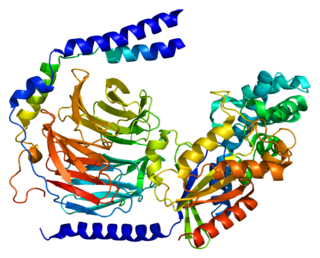Polycystic kidney disease 2-like 1 protein also known as transient receptor potential polycystic 2 (TRPP2; formerly TRPP3) is a protein that in humans is encoded by the PKD2L1 gene. [5]
Polycystic kidney disease 2-like 1 protein also known as transient receptor potential polycystic 2 (TRPP2; formerly TRPP3) is a protein that in humans is encoded by the PKD2L1 gene. [5]
TRPP2 is a member of the polycystin protein family. TRPP2 contains multiple transmembrane domains, and cytoplasmic N- and C-termini. TRPP2 may be an integral membrane protein involved in cell-cell/matrix interactions. TRPP2 functions as a calcium-regulated nonselective cation channel. Alternative splice variants have been described but their full length sequences have not been determined. [5]

Autosomal dominant polycystic kidney disease (ADPKD) is one of the most common, life-threatening inherited human disorders and the most common hereditary kidney disease. It is associated with large interfamilial and intrafamilial variability, which can be explained to a large extent by its genetic heterogeneity and modifier genes. It is also the most common of the inherited cystic kidney diseases — a group of disorders with related but distinct pathogenesis, characterized by the development of renal cysts and various extrarenal manifestations, which in case of ADPKD include cysts in other organs, such as the liver, seminal vesicles, pancreas, and arachnoid membrane, as well as other abnormalities, such as intracranial aneurysms and dolichoectasias, aortic root dilatation and aneurysms, mitral valve prolapse, and abdominal wall hernias. Over 50% of patients with ADPKD eventually develop end stage kidney disease and require dialysis or kidney transplantation. ADPKD is estimated to affect at least one in every 1000 individuals worldwide, making this disease the most common inherited kidney disorder with a diagnosed prevalence of 1:2000 and incidence of 1:3000-1:8000 in a global scale.

Fibrocystin is a large, receptor-like protein that is thought to be involved in the tubulogenesis and/or maintenance of duct-lumen architecture of epithelium. FPC associates with the primary cilia of epithelial cells and co-localizes with the Pkd2 gene product polycystin-2 (PC2), suggesting that these two proteins may function in a common molecular pathway.
TRPP is a family of transient receptor potential ion channels which when mutated can cause polycystic kidney disease.

Polycystin 1 is a protein that in humans is encoded by the PKD1 gene. Mutations of PKD1 are associated with most cases of autosomal dominant polycystic kidney disease, a severe hereditary disorder of the kidneys characterised by the development of renal cysts and severe kidney dysfunction.

Transient receptor potential canonical 1 (TRPC1) is a protein that in humans is encoded by the TRPC1 gene.

Polycystin-2 is a protein that in humans is encoded by the PKD2 gene.

Guanine nucleotide-binding protein G(I)/G(S)/G(O) subunit gamma-2 is a protein that in humans is encoded by the GNG2 gene.

Troponin I, fast skeletal muscle is a protein that in humans is encoded by the TNNI2 gene.

Voltage-dependent L-type calcium channel subunit beta-4 is a protein that in humans is encoded by the CACNB4 gene.

HCLS1-associated protein X-1 is a protein that in humans is encoded by the HAX1 gene.

Troponin C, skeletal muscle is a protein that in humans is encoded by the TNNC2 gene.

Kv channel-interacting protein 4 is a protein that in humans is encoded by the KCNIP4 gene.

Polycystic kidney disease is a genetic disorder in which the renal tubules become structurally abnormal, resulting in the development and growth of multiple cysts within the kidney. These cysts may begin to develop in utero, in infancy, in childhood, or in adulthood. Cysts are non-functioning tubules filled with fluid pumped into them, which range in size from microscopic to enormous, crushing adjacent normal tubules and eventually rendering them non-functional as well.

Autosomal recessive polycystic kidney disease (ARPKD) is the recessive form of polycystic kidney disease. It is associated with a group of congenital fibrocystic syndromes. Mutations in the PKHD1 cause ARPKD.

CatSper1, is a protein which in humans is encoded by the CATSPER1 gene. CatSper1 is a member of the cation channels of sperm family of protein. The four proteins in this family together form a Ca2+-permeant ion channel specific essential for the correct function of sperm cells.

CatSper2, is a protein which in humans is encoded by the CATSPER2 gene. CatSper2 is a member of the cation channels of sperm family of protein. The four proteins in this family together form a Ca2+-permeant ion channel specific essential for the correct function of sperm cells.

Polycystic kidney disease 2-like 2 protein (PKD2L2) also known as transient receptor potential polycystic 5 (TRPP5) is a protein that in humans is encoded by the PKD2L2 gene.
PKD domain was first identified in the polycystic kidney disease protein, polycystin-1, and contains an Ig-like fold consisting of a beta-sandwich of seven strands in two sheets with a Greek key topology, although some members have additional strands. Polycystin-1 is a large cell-surface glycoprotein involved in adhesive protein–protein and protein–carbohydrate interactions; however it is not clear if the PKD domain mediates any of these interactions.
The Polycystin Cation Channel (PCC) Family consists of several transporters ranging in size from 500 to over 4000 amino acyl residues (aas) in length and exhibiting between 5 and 18 transmembrane segments (TMSs). This family is a constituent of the Voltage-Gated Ion Channel (VIC) Superfamily. These transporters generally catalyze the export of cations. A representative list of proteins belonging to the PCC family can be found in the Transporter Classification Database.

Polycystic kidney disease 3 is a protein that in humans is encoded by the PKD3 gene.